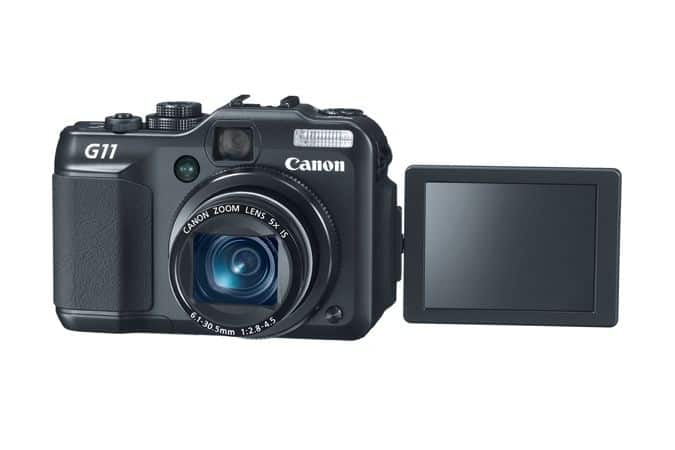Table of Contents
amazon Canon PowerShot G11 reviews
Canon PowerShot G11 is the latest in the G series luxury travel camera series from Canon. Launched as a replacement for the Canon PowerShot G10 predecessor, the product targets audiences who demand high image quality but are afraid to carry heavy, complex DSLRs. Along with the “S90” release at the same time, the Canon PowerShot G11 represents the ambition to push back the influence of the Panasonic Lumix LX3 on the compact semi-professional compact.
G11 owns the rough and slick design of the predecessor G10 with the strongest black lines. The product may be more suitable for men than for women – who are always fond of slim, neat. It measures 112 x 76 x 48 mm, weighs about 402 grams with an SD card and battery. With the G11, users feel the machine is designed very firmly and dress like a miniature DSLR.
Many people will panic when new to G11 because the machine has too many … button. Compared to the previous version, the control system on the G11 almost did not change much. The brightness compensation button is arranged on the top left. This design allows users to control the machine very quickly with both hands. The G11’s double rotating disc has two functions: change the ISO sensitivity (lower) and change the shooting mode (on). The camera is equipped with a flash and hotshoe base compatible with many Canon Speedlite series.
The G11’s optical viewfinder is small and covers only 79% of the frame. However, this is also the downside of the compact size compact. In return, the LCD screen of the machine is bright and sharp with a size of 2.8 inches, resolution 461,000 pixels. This screen uses the PureColor II VA anti-glare technology, which allows good viewing under intense light conditions such as in the sun or in the lab. Despite the smaller size of the G10 and Lumix LX3 LCDs, the G11’s screen has the ability to flip versatile, enabling shooting in a variety of complex situations.
Like most Canon PowerShot models, some of the most important customizations on the G11 are hidden in the Function menu and can be started up quickly by pressing the FUNC / SET key. Other configuration settings can be found in the main menu. The interface of the machine is not so impressive because the icons and letters are a bit monotonous, however, the operation is relatively efficient and intuitive. The Hints and Tips feature gives a brief description of a setting that the user chooses on the Menu. This minor change makes it easier to familiarize and control the machine.
The G10 is similar to the 28-140 mm focal length of a 35mm (5x optical) lens. Of course, Canon has carefully equipped for this high-end version of the optical anti-shake mechanism that increases the exposure time to up to 4-stops compared to normal. The aperture of the lens reaches a maximum f / 2.8, far behind the LX-3 with “Leica f / 2.0”. However, the LX3 only 2.5x zoom with 24-60mm focal range, a little inconvenient for shooting distance. Speed on G11 is quite fast but less accurate if the subject needs a low contrast.
where can you get a Canon PowerShot G11 online
Canon PowerShot G11 10MP Digital Camera with 5x Wide Angle Optical Stabilized Zoom and 2.8-inch articulating LCD: Buy it now
Canon camera Power Shot G11 PSG11: Buy it now
The distortion created by the lens on the G11 is average (about 0.8%) at the widest angle and barely noticeable when zoomed in to the maximum. The image is quite from the heart to the edge. Rigorous tests show that high-end G11 lenses capable of handling purple fringing appear in high contrast areas are not inferior to Panasonic’s Lumix G 20mm f / 1.7. The G11 is also capable of shooting macro at very close distance, corresponding to 31 x 23 mm real-space. Macro quality is rated as perfect. However, the close shooting distance in this mode makes the lens almost cover the light emitted by the flash.
The G11’s sensor remains the same 1 / 1.7 inch size as the predecessor G10. However, now the resolution is only 10 Megapixel, the same Lumix LX3, but much lower than the density of 14.7 million pixels on the G10 sensor. Canon was very wise to create this “step back” for his famous G-series. At the same size, sensors that integrate fewer pixels will produce less noise and a more flexible range of colors. Along with improvements in processing algorithms on the DIGIC 4 chip, the G11 has the ability to produce far less noise and richer detail shots than the predecessor G10 and also slightly better than the Panasonic Lumix LX3. However, this improvement is not much and does not seem to be worth the cost of cutting the megapixel on the G11.
The white balance of the machine works excellently under all conditions, even when shooting with the hard light source of the filament lamp. Pictures tend to be yellowish-green, but not significant.
Continuous shooting speed of the machine is disappointing, only about 1.1 frames per second, less than competitor LX3 2.5 frames per second. In contrast, the G11 allows continuous recording until the memory card is full and Panasonic’s product is limited to four JPEGs or three RAW images. The G11 also appears to be slow to catch up to 2.3 seconds between consecutive JPEGs in single shot mode. This number increased to 4.5 seconds if using the flash at the strongest power.
Similar to the G10, the G11 also has a video capture capability up to 640 x 480 pixels, a frame rate of 30 frames per second (H.264 MOV). NB-7L battery of the machine helps capture about 390 shots if fully charged.

